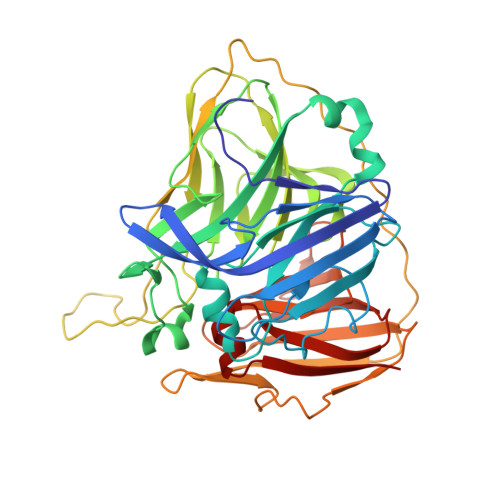The beta-hairpin from the Thermus thermophilus HB27 laccase works as a pH-dependent switch to regulate laccase activity.
Miranda-Blancas, R., Avelar, M., Rodriguez-Arteaga, A., Sinicropi, A., Rudino-Pinera, E.(2021) J Struct Biol 213: 107740-107740
- PubMed: 33962016
- DOI: https://doi.org/10.1016/j.jsb.2021.107740
- Primary Citation of Related Structures:
6Q29, 6TYR - PubMed Abstract:
The multi-copper oxidase from the hyper-thermophilic bacteria Thermus thermophilus (Tth-MCO), has been previously characterized and described as an example of a laccase with low catalytic properties, especially when it is compared with the activity of fungal laccases, but it is active at high temperatures. Structurally, Tth-MCO has a unique feature: a β-hairpin near the T1Cu site, which is not present in any other laccases deposited at the PDB. This β-hairpin has an expected crystallographic behavior in solvent-exposed areas of a crystallized protein: lack of electron density, high B-values and several crystalline contacts with neighboring crystallographic copies; however, its dynamical behavior in solution and its biological implications have not been described. Here, we describe four new Tth-MCO crystallographic structures, and the β-hairpin behavior has been analyzed by molecular dynamics simulations, considering the effect of pH and temperature. The β-hairpin new crystallographic conformations described here, together with their dynamics, were used to understand the pH-restrained laccase activity of Tth-MCO against substrates as syringaldazine. Remarkably, there are insertions in laccases from Thermus and Meiothermus genus, sharing the same position and a methionine-rich composition of the Tth-MCO β-hairpin. This unique high methionine content of the Tth-MCO β-hairpin is responsible to coordinate, Ag +1 and Hg +1 in oxidative conditions, but Cu +1 and Cu +2 are not coordinated in crystallographic experiments, regardless of the redox conditions; however, Ag +1 addition does not affect Tth-MCO laccase activity against syringaldazine. Here, we propose that the pH-dependent β-hairpin dynamical behavior could explain, at least in part, the inefficient laccase activity displayed by Tth-MCO in acidic pH values.
Organizational Affiliation:
Departamento de Medicina Molecular y Bioprocesos, Instituto de Biotecnología, Universidad Nacional Autónoma de México, 2001 Universidad Av., Cuernavaca, Morelos 62210, Mexico; Instituto de Investigación en Dinámica Celular, Universidad Autónoma del Estado de Morelos, 1001 Universidad Av., Cuernavaca, Morelos 62209, Mexico.

















